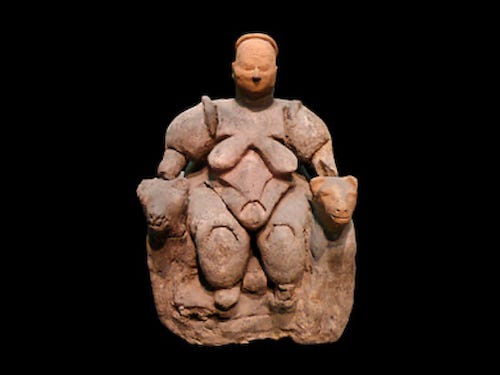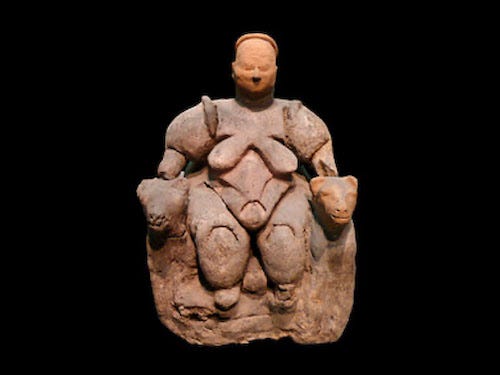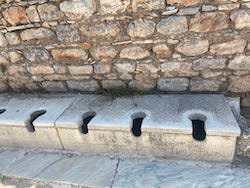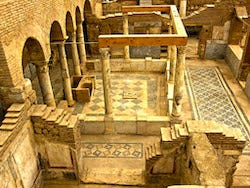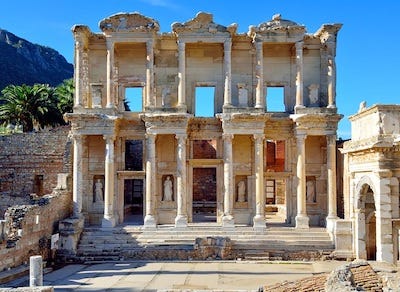When I Find Myself In Times Of Trouble
Just got back from our first major overseas trip since the BeforeTimes, to a fascinating gathering on the coast of the Aegean Sea.
Dr. Mark Hyman from the Cleveland Clinic was there, along with Gabor Mate and one of my all time heroes Harvard anthropologist, TED legend, and Nat Geo explorer Wade Davis, (plus hundreds of other really interesting and creative folks).
The event kicked off as a full moon rose over the hillsides, and a trio of Anatolian folks singers led us in a welcoming ritual of music. Then we followed an ancient folk tradition of tying ribbons on a big olive tree to secure our hopes for the coming season.
It was a ceremony dedicated to the Mother Goddess Kybele, the "Mountain Mother'' who had presided over this chunk of Asia Minor long before the Turks, Romans, or Greeks had ever showed up. Always flanked by two lions, she presided over death, birth, and all the wild animals.
That same night, we went to a cocktail party on a hillside looking west straight to the Greek isle of Patmos, where John supposedly penned his fever dream Book of Revelations, detailing precisely how the End of Days will come.
It was a bizarrely fitting moment, since I'd come to give a talk titled "It's the End of the World, and You Know It (But We'll Be Fine)." Two thousand years of false starts and mishits, and now we're finally here, it seems.
A few days later, we found ourselves with a few new friends (including a couple of Russian creative artists, who had self-exiled from their country) mountain biking to the Temple of Apollo, one of the largest shrines of antiquity.
Alexander the Great had stopped by en route to wider conquests, where the oracle (sister to the one at Delphi) had told him "you will be king of the world, but die young." After which he proceeded to live up to both.
(Pro Tip: if you're traveling in the Mediterranean and have an itch to see the classics of Italy and Greece but can't stomach the tourist traps––consider hopping to the other shore of the Adriatic and Aegean for just as spectacular ruins with a fraction of the crowds. If you're stoked on Venice, check out Split, Croatia, home of Emperor Diocletian's palace. If you're fired up on Delphi and Corinth in Greece, check out Ephesus and Miletus. Those old empires rarely obeyed the lines on the maps we've drawn since, and were much more connected by sail than road)
But the next day's adventure is what really blew our minds.
Exploring the Ancient Ruins
That was when we headed to the ancient city of Ephesus, home at its peak to over a quarter of a million souls, and site of the Temple of Artemis, one of the Seven Ancient Wonders of the World. (Artemis/Diana, the goddess of the hunt, took over from Kybele as the new mother goddess in town, with a lion and a leopard as her familiars).
It was also where Paul ne Saul of Tarsus (also nearby in Asia Minor), came post crucifixion, pissed off the locals and got confined to house arrest in a cave up in the hills. And Mary––legend has it that Mother Mary spent her last days there too.
We started at the Eastern Gate, where all the land-bound travelers would have first arrived, and had to submit their papers to the ancient equivalent of customs and immigration. (Even then, "build the wall" was a political winner).
Then, owing to the fact that overland travel was generally pretty hot and dusty, there was a mandatory stop at the public bathhouse for a scrubadub/delousing before entering the city proper.
Once inside the city streets, we came across a small amphitheater which served as city hall for the senators and debates, then past the fancy streetside shops to the places we've all heard of vaguely before––the Agora––the outdoor shopping mall, and the Stoas––the shaded porticos where people hung out, worshiped, played music and debated. The fancy Guccis and Balenciaga types got nice marble storefronts in the shade, while the street vendors had to hawk their wares in the dust and heat.
Then there was the Temple of the Seven Vestal Virgins, all first born daughters of the elites of the city. They were chosen to serve for thirty years, after which they could return to civic life. But few did. Serving Vesta, the Virgin goddess of hearth and home, was such an honored position that many devoted their lives to her. (More about this in a minute).
After the public spheres near the town entrance, dedicated to governance and worship, we moved into the more secular section leading down to the harbor. There the swanky private baths served as a spa and Soho House of the ancient world. They had glazed clay pipes plumbing in water (carried in aqueducts from up to 40km away!), heated floors, and wood fired hot water plunge pools and cold pools. (And we like to think our current biohacking is so new!) 3pm sharp everyday, and the elites called a halt to their work and all met up there.
Beneath the baths were the public commodes. Sweet little keyhole toilet seats over the sewer pipes beneath, all flushed clear by the graywater from the bathhouses. A stream of clean water flowed in front of the seats, providing a little spot to rinse your bidet sponge (so definitely best to sit at the upstream stall). It was amazing to see the low tech/high tech design of this place, so much more elegant (and gravity fed) than our current water/sewer/power works.
Another turn, past little games of chance scratched into the marble stairs to entertain vendors in between customers, a Jewish menorah carved into a wall, a Christian cross carved into a lintel much later in the game, a bit of graffiti pointing the way to the brothel, and then onto the palatial row houses of the city's elites.
There were seven of them, layered into the hillside above the main road––with courtyards providing fresh air and light, and then inside to lavish dining rooms, bathrooms (with hot and cold running water and fountains) and incredible mosaic flooring and gorgeous wall paintings on panels of marble.
In the most impressive of these homes, owned by the High Priest of Vesta, there were even secret grottoes and chambers for the "down low" late night rituals they only conducted in private.
That's when they had symposia––which literally means "to drink together" where everyone brought their own wine and mixed it into a giant container and then got hammered while discussing a specific topic of the evening (kind of like our Jeffersonian Dinner conversations we've often hosted at our live events).
Where Did the Opulence Come From?
When asking our guide, what was the source of all of this incredible abundance, she replied "olives, textiles, and (uncomfortable pause)... slaves."
Turns out, Ephesus was one of the major slave trading ports of the entire Mediterranean and a central processing station for the expanding Roman Empire's human trafficking operations. Everyone came there to stock up on manual laborers, artisans, tutors, accountants and anyone else they needed.
As Yale historian Edmund Morgan wrote about the United States relationship with slavery, enslavement was a feature of Greece, Rome and America, not a bug. The only way the fragile experiment of democracy was ever attempted was in the three societies that explicitly denied it to some of their population. It's impossible to separate the "grandeur" of ancient Rome (or Greece, or the American South) from the fact that forced labor got it done.
So there's that.
All the beautiful marble. All the technological wonders. All the near-photo-realistic mosaics painstakingly comprised of tiles 1cm on a side. All of it built on the backs of slaves.
Kind of takes the sheen off a bit.
When we left the palatial townhomes and went down to the coliseum––the epic 25,000 person arena that sat smack dab at the head of the road to the harbor, we noticed something else.
The sea was miles away from the old harbor.
The whole bay that had served as the port to one of the most bustling cities in all of the empire, had silted up. Navigable water today was miles off in the distance.
Turns out that all of those super awesome wood fired masonry heaters and hot tubs that made those Roman baths so epic, had also totally denuded the surrounding hillsides of trees. Which, come rainy season, had proceeded to obey the laws of hydrology and promptly carried all that unrooted dirt down into the rivers and streams and into an increasingly silted up harbor.
Kind of like the mudslides in Colorado last summer which closed off I-70 after the wildfires of the year before.
Throw in a couple of doozy earthquakes, a handful of civil wars, violent invasion and market collapses, and Ephesus, once one of the three most powerful cities of the ancient world (along with Rome and Alexandria), faded into obscurity. Sure, people tried to rebuild in dribs and drabs from time to time, but mostly, they were scavengers picking through scraps, rarely with the time, talent or wealth to restore things to their former glories.
Even today, 80% of its ruins are buried under rolling hillsides of poppies and wild wheat (Ephesus, not coincidentally, was the first place that grain was ever domesticated!).
It's a cliche of classical scholars to look into the camera in the final minutes of a documentary and surmise "so really, the ancients are just like us, sharing all the hopes and dreams, triumphs and disasters of humans everywhere." But it's unnervingly true. Take away plastic and wifi and there's humblingly little that's core to our lives that was absent in theirs.
We can marvel at their low tech ingenuity, piping and heating water from miles away, building coliseums that still inspire the stadiums of today, hosting intoxicating dinners with purpose, and practicing mysteries that mattered. Including immigrants and layers of faiths, cultures forever overlapping, blending, merging, with each other to forge something both familiar and new. Excluding others, and behaving cruelly to those deemed unworthy of full humanity or citizenship. Prizing learning and libraries as bellwethers of civilization.
And also, overstripping their natural resources, upsetting the ecology of their ecosystems. Suffering diseases and disasters and sometimes forgetting the advancements of the last high water mark, only to "stoop to build them up again with worn out tools."
Once empire starts to slide, it's a slippery slope to the bottom. (Note to us).
Drifting Between Worlds
Our minds were fully blown as we left Ephesus. We felt unstuck in time, drifting between worlds. (Another side benefit of Covid was no hordes of Wall-E tourists descending from cruise ships. Other than a few sweet groups of middle school kids on end of year field trips, the place was pretty much empty).
But there was one more stop on our tour. The House of Mary. High up outside the walls of Ephesus was a little mountain grotto, a chapel built into the hillside on top of a spring (seems like pretty much every major temple gets its start like that). It's the spot that, legend has it, Mary came after fleeing Jerusalem, and spent her final days.
It was nearing sunset, and, aside from a priest and a few groundskeepers, we were the only folks still there. We dipped our heads in, felt the cool stone of the walls, looked at the shrine, and even filled a glass bottle from the spring with the holy water still pouring from its stone walls.
Whether or not Mary actually lived there is hard to say. Three popes have visited the place in the past century, and millions of pilgrims treat it as a shrine. The original foundations date back to the Apostolic era, but the hard evidence is scant. (Mostly drawing circumstantially from the fact that Paul and John can be placed there, and Jesus had supposedly told them to look after his Ma).
But then there's this little tale that adds a layer of mojo to the whole inquiry.
In the 19th century, an invalided German nun Anne Katherine Emmerich had mystic visions of Mary's final days, describing her home, its proximity to Ephesus and even that she could see the isle of Patmos from her perch. Emmerich had never left Germany, but decades later some priests took her verbal account and traveled to Ephesus seeking the spot.
Sure enough, it led them to the ruins of this little chapel which matched the nun's vision perfectly. And while there's still some debate as to how much after-the-fact fudging was done to mythologize that particular tale, one other fact seems to stand.
When the German priests got there, they found that nearby villagers had been making pilgrimages to that sacred spring, every year on August 15th (the nominal date of Mary's ascension) since the fifth century! So long before the Euros came in to validate the visions of their mystic sister, the locals had been keeping the faith in almost pagan reverence.
Words of Wisdom
Which brings us full circle back to that opening night under a full moon, singing songs and offering prayers to Kybele, the Mother of the Mountain, goddess of wild animals, and the harvest.
And then on to Artemis, queen of the hunt, and Vesta, angel of the home and hearth. To Mother Mary herself. (Turns out Vesta’s chastity rubbed off, and it was at the Council of Ephesus in 431 CE that the Church formally put the Virgin in Virgin Mary).
Seems that she never changed, really. We did.
So as we find ourselves in times of trouble, Mother Mary comes to We. To all of us, regardless of what faith we keep or flag we fly.
And if we listen carefully, we still might be able to hear some of her words of wisdom.
Earthquakes, fires, floods, and famines will plague us, as they always have.
Conquerors, enslavement, civil war and cruelty may overwhelm us, as they often do.
But through it all, the moon will rise, and the seasons will turn.
The mountains will heal. The seas will mend.
If we can keep the faith, and tend the springs, (and honor the Mother),
there will be an answer.
"For when the brokenhearted people
Living in the world agree
There will be an answer
Let it be."
Let it be!
Jamie



